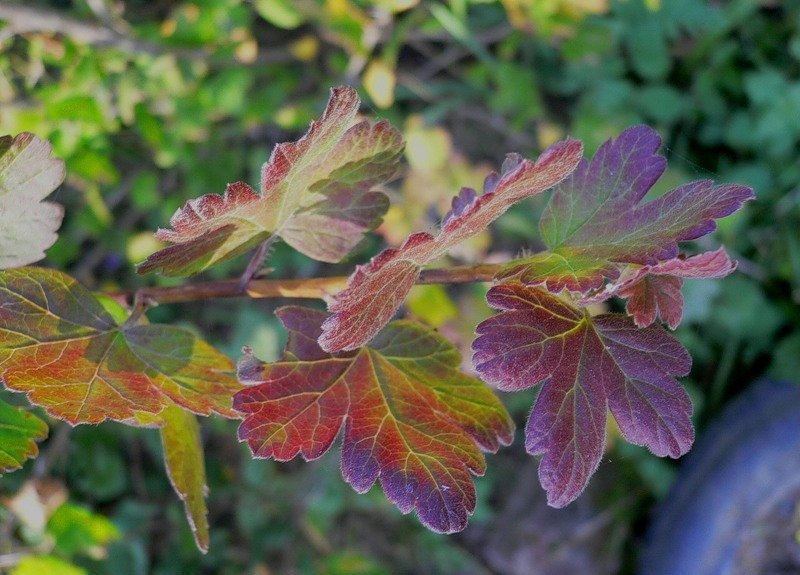 Most gardeners make the same mistake after harvesting gooseberries. They simply stop caring for the plant, switching their attention to other crops. At the end of summer, when there is less work on the site, people remember about the bush.
Most gardeners make the same mistake after harvesting gooseberries. They simply stop caring for the plant, switching their attention to other crops. At the end of summer, when there is less work on the site, people remember about the bush.
And here unpleasant surprises can wait, one of which is a red border on the leaves.
Content
What does red border on gooseberry leaves mean?
Normally, gooseberry leaves have a uniform green color. Over time, the old leaves fade and dry, and new ones grow. But they should not acquire new shades. If spots, stains or borders appear on the plant, this may indicate:
- lack of nutrients;
- illnesses;
- negative impact of environmental factors.
Nutritional deficiency
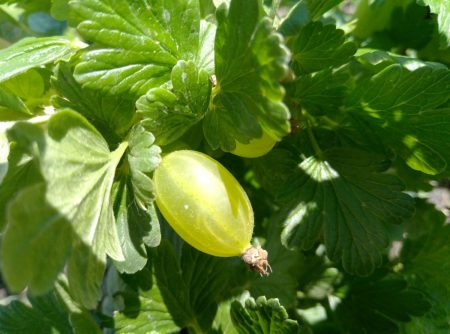 For normal development, gooseberries need adequate watering, good air circulation, normal lighting, and proper nutrition.
For normal development, gooseberries need adequate watering, good air circulation, normal lighting, and proper nutrition.
It consists mainly in the use of complex fertilizers containing nitrogen, potassium, calcium, phosphorus and other components. Also, nutrients can be applied under the bush individually with the help of ready-made store preparations or folk remedies. Gooseberries can indicate a nutritional deficiency in different ways, but the appearance of a red border indicates a lack:
- nitrogen. In this case, the leaf first turns pale, becomes light green, then turns yellow, loses its juiciness, after which red spots appear on it. At first they can be located on one side, but with time spread along the entire perimeter;
- phosphorus. The leaf turns yellow from the edges to the center, a red border appears along the very edge, in parallel, they begin to turn red or acquire a purple hue of the vein and petiole;
- potassium. In this case, the sheet first begins to turn yellow, then a red, brown or purple border appears along the very edge. In parallel, at the place of its formation, the leaf dries, crumbles in parts;
- calcium. The leaf turns yellow, a red border appears on the edges. At the same place, the sheet begins to curl inward;
- magnesium. First, gray spots appear between the veins and around the petiole, and then the edge of the leaf begins to redden. They can bend outward.
With an excess of chlorine in the soil on the leaves, a red-burgundy strip along the very edge can also appear. But it very quickly turns to gray, and the affected part crumbles when touched by dust. This marginal necrosis is a serious disease that you should not fight on your own.
Disease
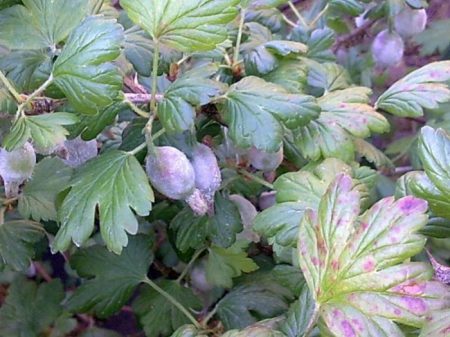 Gooseberries - the culture is quite resistant to diseases and pests. But there is a slight minus in this. When infected, the bush does not immediately “give out” all the symptoms of the disease. The real problem becomes noticeable 3-5 years after infection, when it is too late to take action. But according to the appearance of the red border, it can be concluded that the plant needs help.
Gooseberries - the culture is quite resistant to diseases and pests. But there is a slight minus in this. When infected, the bush does not immediately “give out” all the symptoms of the disease. The real problem becomes noticeable 3-5 years after infection, when it is too late to take action. But according to the appearance of the red border, it can be concluded that the plant needs help.
Such a sign may indicate the following diseases:
- Ascochitosis. This is a fungal infection. It appears at the end of summer and even the beginning of autumn, when the leaves on the gooseberry turn red and fall. You can determine it by pressing on the middle of the leaf (if it becomes infected with a fungus, it becomes brittle, crumbles), as well as inspecting its lower side and finding spores;
- columnar rust. It appears in early spring. At risk are shrubs located near pines and cedars.The winter fungus selects these trees, and in the spring it “moves” to berry crops. On the upper side of the sheet not along the very edge, but at a certain distance from the middle, red-brown spots form, which merge into one strip, and then eventually occupy the remaining surface. Below, everything is dotted with orange spores;
- leaf spot or septoria. The problem is already noticeable in early June. Light yellow spots appear on the leaves, which eventually transform into a burgundy border;
- cercosporosis or brown spotting. You can notice the disease in the middle of summer. Irregular spots appear on the leaves, which later acquire a dull burgundy hue and plaque on both sides of the leaf.
All gooseberry diseases are united by a common symptom - productivity decreases sharply, the formation of young shoots ceases and foliage falls off the bush much earlier.
Environment
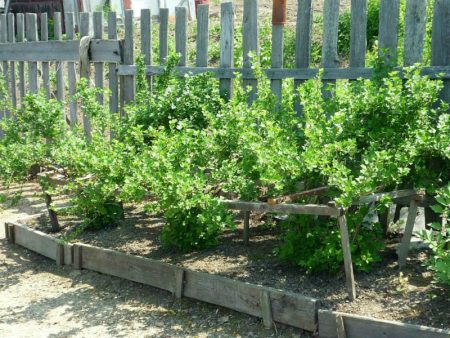 Natural factors with the appearance of a red border on the leaves of gooseberries should also not be discounted. Like other plants, the bush needs rainwater. If there is a drought, even with regular watering, the plant may not have enough moisture. Yes, and the rain, after which the sediment remains on the plants, today also does not surprise anyone. Such a reaction to dirty water can also occur.
Natural factors with the appearance of a red border on the leaves of gooseberries should also not be discounted. Like other plants, the bush needs rainwater. If there is a drought, even with regular watering, the plant may not have enough moisture. Yes, and the rain, after which the sediment remains on the plants, today also does not surprise anyone. Such a reaction to dirty water can also occur.
A red border may appear as a result of sunburn. More often this problem occurs if the gooseberry is after partial shade in the open. For example, a tree branch protecting the bush from the sun broke or was removed, or some kind of temporary building was removed. In this case, you must use a special protective net. Otherwise, there is a risk of serious damage to the plant.
The red border on the leaves actually does not always have such a pronounced color. Hue can range from light pink to bright purple and dark brown.
Treatment is effective
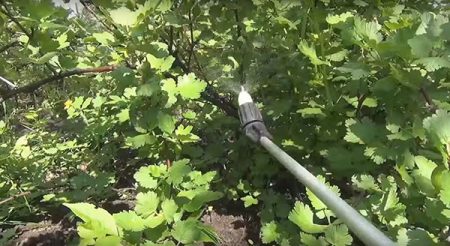 In early spring, before flowering, the bushes should be sprayed with a 1% solution of Bordeaux fluid. The procedure will not hurt to repeat at the stage of budding, at the time of flowering, during the formation of fruits and after harvesting. If the defeat by pests or infection was severe, it is necessary to spray twice before the onset of cold weather, but this method is suitable for prevention, as well as for the treatment of those plants whose damage was noticed last year.
In early spring, before flowering, the bushes should be sprayed with a 1% solution of Bordeaux fluid. The procedure will not hurt to repeat at the stage of budding, at the time of flowering, during the formation of fruits and after harvesting. If the defeat by pests or infection was severe, it is necessary to spray twice before the onset of cold weather, but this method is suitable for prevention, as well as for the treatment of those plants whose damage was noticed last year.
At the first signs of the disease, all infected parts of the plant should be removed and burned away from the garden. Treat bushes with fungicides.
It is necessary to spray not only a sick bush. All similar crops in the garden are subject to processing. This means that in addition to gooseberries, currants and raspberries also need protection.
A plant that is undernourished needs help, using the necessary nutrition. You can purchase the necessary drugs in the store, or you can act the old fashioned way, applying:
- ammonium nitrate. The solution is prepared from a bucket of water and a tablespoon with a slide of saltpeter. Half a bucket flows under each young bush, and a whole bucket can be grown under adult plants;
- wood ash. The solution is prepared from a glass of ash bucket of water. You can use both root dressing, and for external spraying. This will help both fertilize the bush and scare away pests;
- decoction of potatoes. For a third, the pan must be filled with cleanings, top up with water. Bring to a boil, boil for a couple of minutes, leave to cool. After the broth, strain, dilute in half with water and pour 3-5 liters under each bush, depending on the age of the plant.
To fertilizer is better absorbed into the soil, it is necessary to irrigate the day before. Immediately before the procedure, lightly scrub the soil from the stems, and after applying top dressing, lightly dig the soil.
Resistant varieties
 In order for the gooseberry to give not only an excellent harvest, but also not require special hassle, you need to choose the most proven varieties for growing on the site:
In order for the gooseberry to give not only an excellent harvest, but also not require special hassle, you need to choose the most proven varieties for growing on the site:
- pear Received the name for the slightly elongated shape of the berries. It is characterized by increased immunity, resistance to weather extremes;
- Russian yellow. In addition to its unusual color and rich taste, it has a high immunity, is not afraid of pests, diseases, normally tolerates frosts, high humidity and drought;
- bun. The variety was bred for cultivation in areas where anthracnose, powdery mildew and other most common diseases are common;
- cooperator. It is characterized by increased productivity (more than 5 kg of fruits are collected from the bush), is not afraid of weather changes, rot of fruits and leaves;
- spring. Able to adapt to any environmental conditions, not afraid of fungal infections.
Any variety is able to mutate. Therefore, the result promised by breeders can be expected no more than 3 years.
Prevention
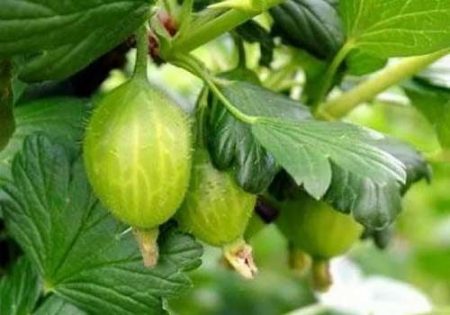 A professional “by eye” will determine the problem that arose when growing gooseberries. But for lovers, due to the similarity of symptoms caused by environmental influences, insufficient fertilizer application and infection by infections, this will be difficult to cope with.
A professional “by eye” will determine the problem that arose when growing gooseberries. But for lovers, due to the similarity of symptoms caused by environmental influences, insufficient fertilizer application and infection by infections, this will be difficult to cope with.
Therefore, it is easier to provide any problems by carrying out the following preventive work:
- annually cut bushes, removing old branches;
- digging the soil around the bush;
- make complex fertilizers;
- spray with a solution of laundry soap or wood ash to protect against pests at least once every 2 weeks.
And most importantly, do not forget about your favorite plant throughout the season and regularly conduct a thorough visual inspection in order to identify the problem in time and take the necessary measures.
Reviews
Marina, 38 years old
Gooseberries grow around the perimeter of the plot. There was never a problem with him, and the year before last, the leaves below began to dry on some bushes, on the middle ones I saw a red border. I cut it off, and only then I realized that it was in vain. It was necessary to observe and find out what was the problem. As a result, three bushes had to be excavated and destroyed, and the remaining two years in a row were treated with Bordeaux liquid and fungicides. I hope that next year there will be a great harvest. The bushes seemed to come to life.
Oksana, 24 years old
Bought a summer house recently. I immediately planned how the bushes of red, black currant and gooseberry would be placed. With their help, I will divide the site into parts. I read a lot of information about caring for these berries. Here are all experienced gardeners advise to pour bushes with steep boiling water in early spring. This destroys pests and fungi, namely they represent the main danger.
Semen Stepanovich, 65 years old
How many years I grow gooseberries, I spray it with soap and water as much as possible. You just need to take the bar, fill it with a bucket of water, leave until dissolved. It’s good if it starts to ferment. Then it is not only protection, but also fertilizer. You can apply with a paint brush or just spray from a spray bottle.
Red border on gooseberry leaves may indicate the presence of various problems. But they all have one thing in common - measures should be taken without delay in order to save not only the suffering plant, but also all other plantings.

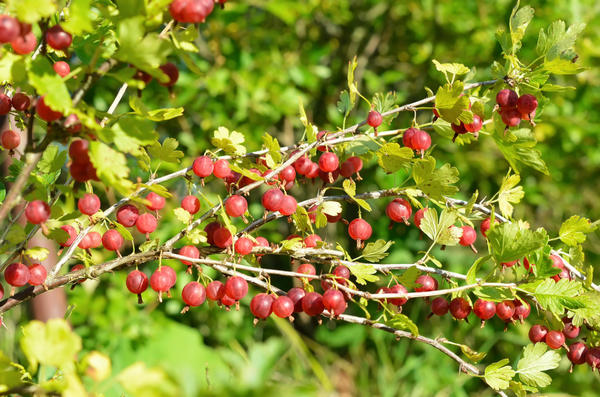
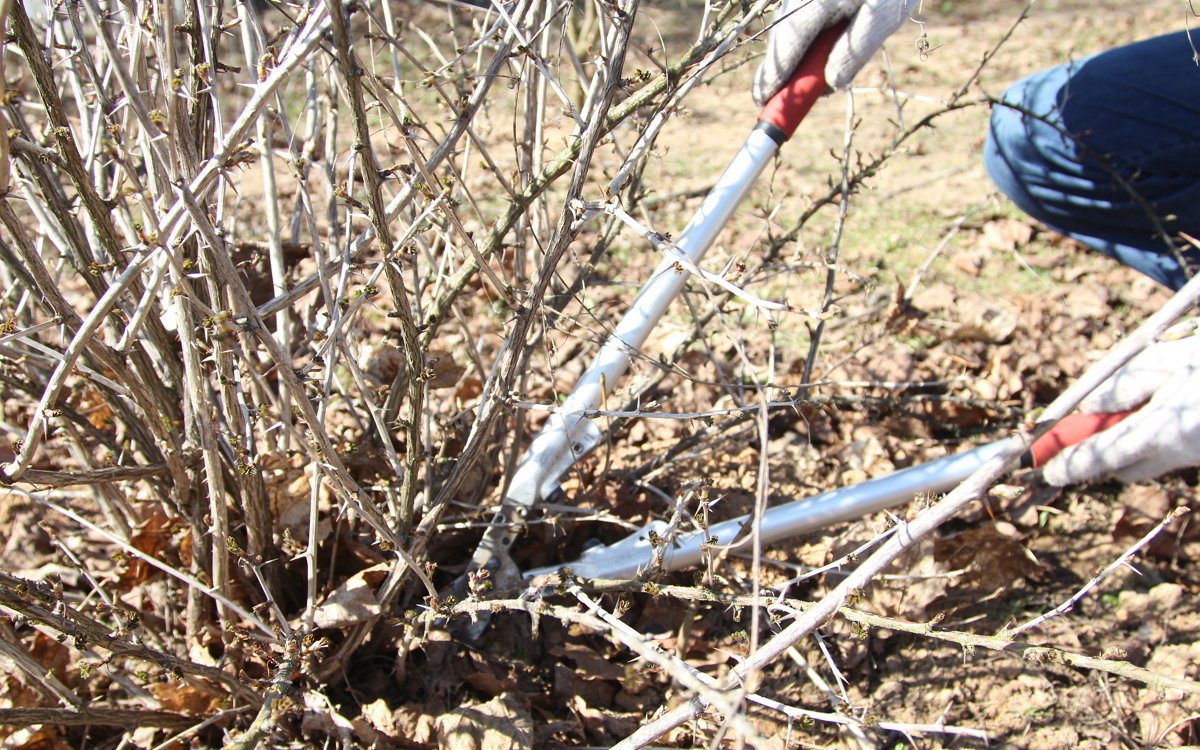
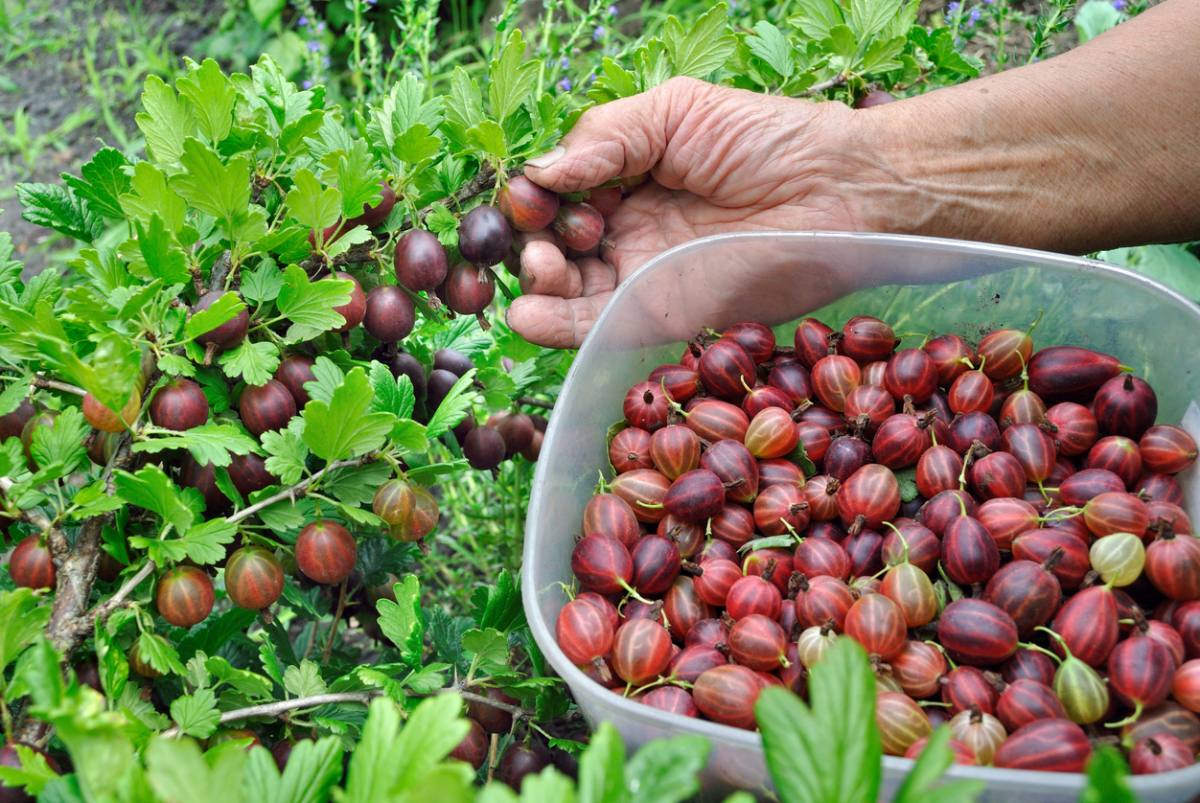
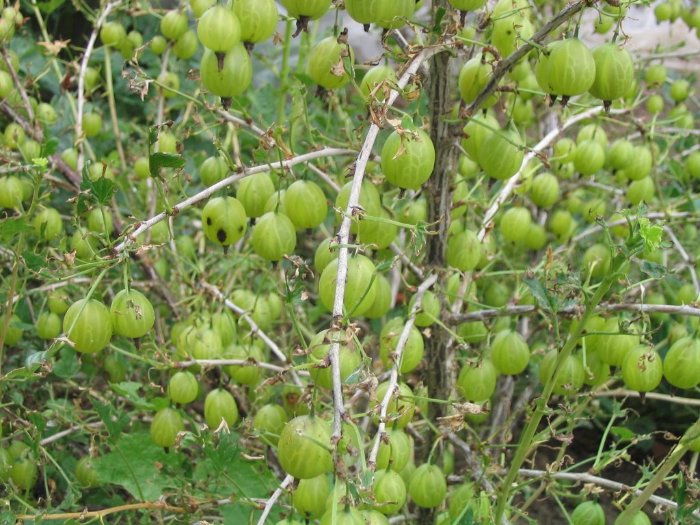 What if gooseberries have eaten all the leaves? Simple tools come to the rescue
What if gooseberries have eaten all the leaves? Simple tools come to the rescue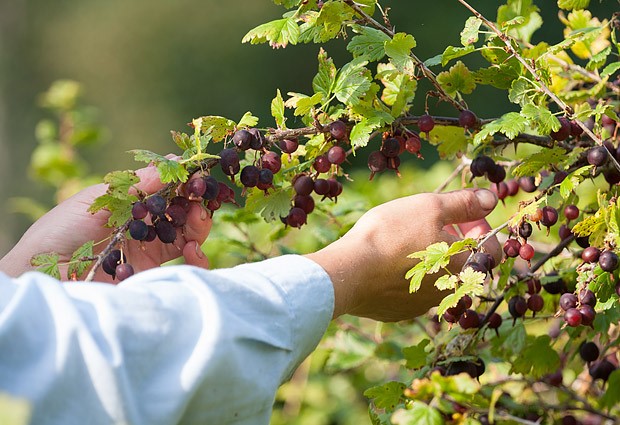 That's the end of summer, it's time to feed gooseberries after harvest
That's the end of summer, it's time to feed gooseberries after harvest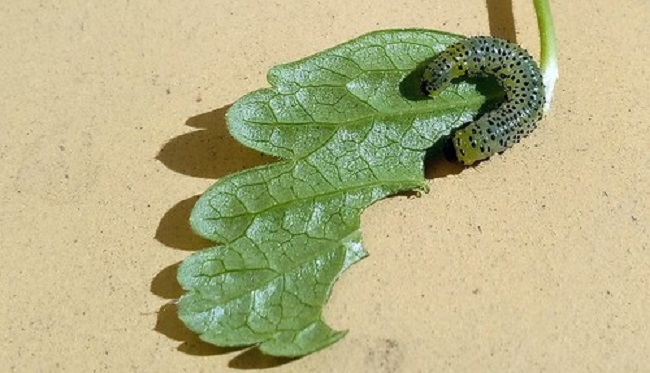 To save gooseberries from the invasion of caterpillars will help vinegar, mustard and ammonia
To save gooseberries from the invasion of caterpillars will help vinegar, mustard and ammonia